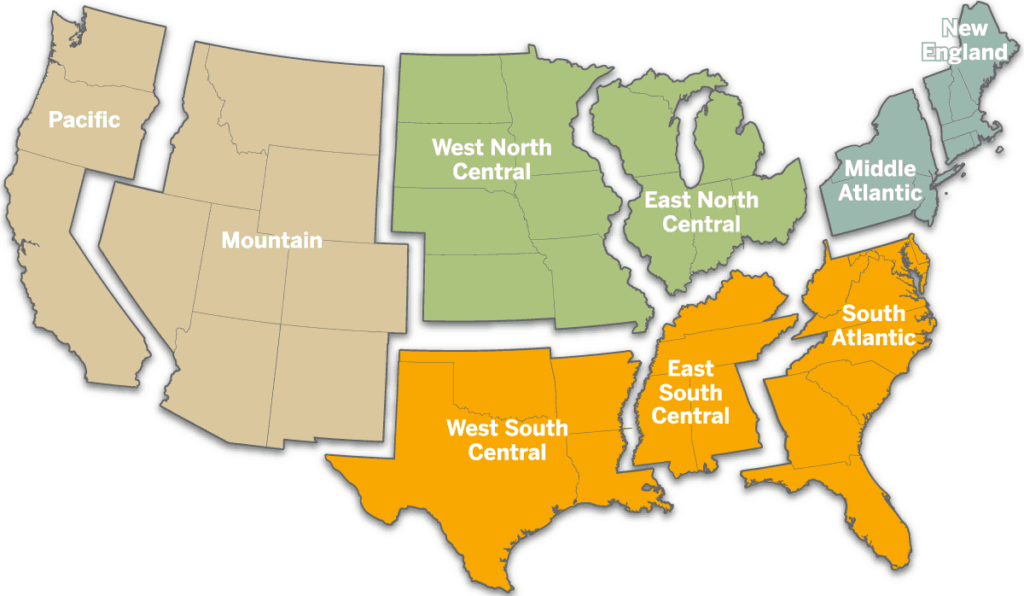Activity Overview: Climate control drives most energy use in the built environment in the United States. Humans like to be comfortable, and they use energy to cool or heat the interior of their homes if they can afford it. One method to estimate the amount of energy required for climate control is the total of heating degree-days and cooling degree-days.
A degree-day is a compound metric measuring either the number of days of 1° change or the number of degrees changed in a one day period. For example, 10 degree-days could be 10 days requiring heating by 1°, or 1 day requiring heating by 10°. The number of heating degree-days in each region varies, but all regions accumulate thousands of heating degree-days each year.
Similarly, cooling degree-days count the number of days and number of degrees of cooling. Ten degree-days of cooling would be 10 days of 1° cooling or 1 day of 10° of cooling. Both heating-degree days and cooling-degree days are based on a base temperature of 65°F in the United States.
This activity is appropriate for individuals and for groups. Project or print the following map and graph for your students. Ask them the following questions about the data.

Working as a class or individually, calculate the number of degree-days in a given week. If you undertake this activity in January, you may be considering heating degree-days. If you undertake this activity in August, you will likely be looking at cooling degree-days. The process is as follows.
Use the weather almanac, newspaper, or an online weather reporting service to collect and record the mean temperature for the day. Repeat this process for five days. Then calculate the number of degrees between 65°F and the mean temperature of each day. The spread of degrees on a single day is the number of degree-days to record for that day. If the mean temperature is higher than 65°F, then the day collects cooling degree-days, because cooling is required. The opposite is true for heating degree-days. If the mean temperature of the day is 65°F, then record 0 degree-days. At the end of the calculations, take a sum of the number of heating degree-days and the number of cooling degree-days. How many degree-days did your region collect this week? Each degree-day collected contributes to the consumption of energy for cooling and heating.
The EIA uses a regional average to calculate the number of respective degree-days to assign to regions throughout the year, but this exercise will introduce students to how quickly energy can be consumed just to keep warm and cool.
The data in these tables was taken from a U.S. weather data almanac for Fredericksburg, Texas. The number of degree-days is calculated as the difference between the average temperature and 65°F. Negative differences denote heating degree-days, and positive differences denote cooling degree-days. Therefore, the dates 1 to 5 October accrue 26.15 cooling degree-days. The dates 27 to 31 October accrue 11.45 heating degree-days.
| Date | Daily High (°F) | Daily Low (°F) | Daily Average | Degree-days |
|---|---|---|---|---|
| 1 | 83.4 | 58.2 | 70.8 | 5.8 |
| 2 | 83.1 | 57.9 | 70.5 | 5.5 |
| 3 | 82.8 | 57.6 | 70.2 | 5.2 |
| 4 | 82.6 | 57.3 | 69.95 | 4.95 |
| 5 | 82.3 | 57.1 | 69.7 | 4.7 |
| Date | Daily High (°F) | Daily Low (°F) | Average (°F) | Degree-days |
|---|---|---|---|---|
| 27 | 75.9 | 50.9 | 63.4 | -1.6 |
| 28 | 75.5 | 50.6 | 63.05 | -1.95 |
| 29 | 75.2 | 50.2 | 62.7 | -2.3 |
| 30 | 74.8 | 49.9 | 62.35 | -2.65 |
| 31 | 74.5 | 49.6 | 62.05 | -2.95 |
TEKS
SS.6.3C, SS.8.10B, SS.6.21C, SS.7.21C, SS.8.29C, SS.6.21F, SS.7.21H, SS.8.29H
MATH.6.2C, MATH.7.3A, MATH.6.3D
A full explanation of degree-days and how the Energy Information Administration calculates and analyzes them is available through the Energy Units and Calculators Explained Series: Degree-Days.
These links are being provided as a convenience and for informational purposes only, and the inclusion thereof does not constitute an endorsement or recommendation. Although we make every effort to ensure these links are accurate, up to date and relevant, we are not responsible for content on third-party sites.

We'd love to help answer any questions and help you get started! Drop us a line and we'll get back to you as soon as we can.
Watt Watchers of Texas
204 E. Dean Keeton Street, Austin, Texas 78712
contact@watt-watchers.com
Nos encantaría contestarle cualquier pregunta que tenga y ayudarle empezar! Envíenos un mensaje y nos pondremos en contacto con usted lo antes posible.
Watt Watchers de Texas
204 E. Dean Keeton Street, Austin, Texas 78712
contact@watt-watchers.com